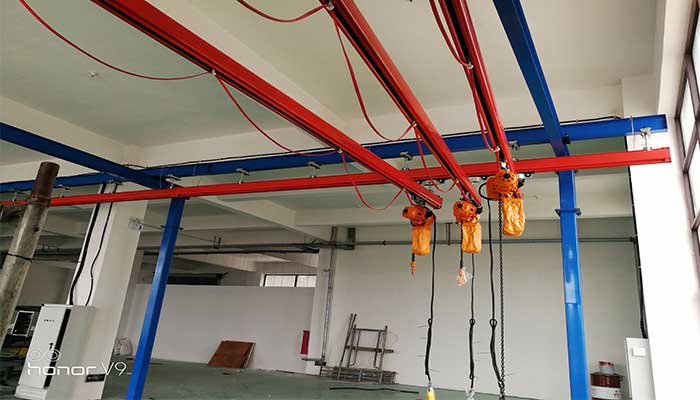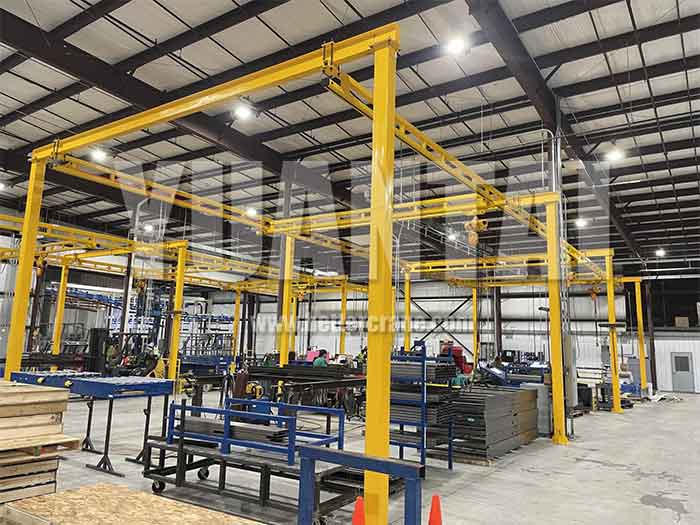Automotive Industrial Cranes, KBK Rail Cranes for Heavy Parts Assembly
KBK rail crane for automotive sector. Custom industrial overhead kbk rail crane for handling & positioning heavy automotive components on assembly lines.
Automotive Industry Crane: Heavy Parts Assembly KBK Rail Cranes
In the ever-evolving landscape of the automotive industry, where precision, efficiency, and innovation reign supreme, advancements in manufacturing processes play a pivotal role. As automakers strive to push the boundaries of what's possible, one key area that stands out is heavy parts assembly. In this dynamic environment, the integration of cutting-edge technologies becomes crucial, and one such innovation taking center stage is the KBK Rail Crane.
The automotive industry stands as a symbol of progress, intertwining technology and craftsmanship to create vehicles that define our modern world. From the early days of assembly lines to the era of electric and autonomous vehicles, the industry has undergone profound transformations. Today, the automotive sector is not only about building cars; it's about pushing the boundaries of design, performance, and sustainability.
Advancements in automotive manufacturing are the driving force behind the industry's ability to adapt, compete, and thrive. As consumer demands evolve and environmental considerations become paramount, automakers face the challenge of producing vehicles that are not only technologically advanced but also sustainable and efficient. Heavy parts assembly, a critical aspect of vehicle manufacturing, demands constant innovation to ensure precision and streamline production processes.
In this context, the importance of advancements in automotive manufacturing cannot be overstated. These advancements not only contribute to the creation of safer and more reliable vehicles but also impact the overall efficiency of production lines. As we delve into the realm of heavy parts assembly, the KBK Rail Crane emerges as a game-changing technology, poised to redefine the way automotive components are handled and positioned on assembly lines. Join us on this journey as we explore the capacities, applications, and real-world impact of KBK Rail Cranes in the automotive industry.
Automotive Industry Advancements: KBK Rail Cranes
In the intricate dance of heavy parts assembly within the automotive industry, the KBK Rail Crane emerges as a technological maestro, orchestrating precision and efficiency. Characterized by its robust design and advanced capabilities, the KBK Rail Crane is a lifting solution engineered to handle the demands of modern automotive manufacturing.
The KBK Rail Crane boasts a remarkable lifting capacity, ranging from 2 tons to 5 tons. This robust capability positions it as a reliable workhorse in the assembly line, capable of seamlessly handling a variety of heavy automotive components. Whether it's engine blocks, chassis components, or intricate machinery, the KBK Rail Crane's lifting capacity is tailored to the diverse needs of the automotive manufacturing process.
Application
In the intricate ballet of heavy parts assembly, where precision is paramount, the application of KBK Rail Cranes takes center stage.
Handling and Positioning Heavy Automotive Components on Assembly Lines
The primary application of KBK Rail Cranes lies in the meticulous handling and positioning of heavy automotive components along assembly lines. From the moment raw materials arrive at the manufacturing facility to the final stages of assembly, these cranes play a crucial role in the movement of components with precision and control.
Key Aspects of Application:
- Raw Material Handling:KBK Rail Cranes facilitate the efficient transportation of raw materials to designated workstations, ensuring a smooth start to the assembly process.
- Intermediate Processes:As components move through different stages of assembly, the cranes are instrumental in their precise positioning, contributing to the seamless flow of production.
- Final Assembly:In the culmination of the manufacturing journey, the cranes delicately position heavy components for final assembly, ensuring accuracy and adherence to quality standards.
The KBK Rail Crane's adaptability and strength make it a cornerstone of heavy parts assembly, allowing automotive manufacturers to elevate their production processes to new heights. As we delve deeper into the significance of these cranes in real-world projects across different countries, the impact of KBK Rail Cranes on automotive manufacturing becomes increasingly apparent. Join us in the next section as we explore notable projects in Germany, the United States, and China, where the KBK Rail Crane has left an indelible mark on the automotive industry.
Significance of Heavy Parts Assembly
In the intricate symphony of automotive manufacturing, heavy parts assembly takes center stage, playing a crucial role in shaping the industry's landscape. As we delve into the significance of heavy parts assembly, we uncover the pivotal role it plays in the creation of modern vehicles.
Role of Heavy Parts in Automotive Manufacturing
Heavy parts, ranging from engine components to chassis elements, form the structural and functional core of vehicles. The role of heavy parts in automotive manufacturing is multifaceted and pivotal:
- Structural Integrity:Heavy components contribute to the structural integrity of vehicles, ensuring they meet stringent safety standards. From the chassis to critical engine components, these elements form the backbone of a vehicle's design.
- Performance Enhancement:Certain heavy parts, such as engine components and drivetrain elements, directly impact the performance of vehicles. The efficiency and precision in assembling these components are paramount to achieving optimal performance levels.
- Safety Considerations:Heavy parts, when assembled correctly, contribute to the overall safety of vehicles. Proper alignment and secure positioning are essential to meet safety regulations and ensure the reliability of vehicles on the road.
Importance of Efficient Handling and Positioning
Efficient handling and positioning of heavy automotive components during the assembly process are integral to achieving several key objectives:
- Precision in Assembly:The intricate nature of modern vehicles demands precision in assembly. Efficient handling ensures that heavy components are accurately positioned, contributing to the seamless integration of various parts.
- Workflow Optimization:Smooth and efficient handling of heavy parts optimizes the overall workflow on the assembly line. Reduced handling time translates to enhanced productivity and minimized downtime.
- Quality Assurance:Proper positioning and handling of heavy components contribute to the quality assurance process. Ensuring that each part is correctly placed is essential to prevent defects, malfunctions, and safety issues in the final product.
- Worker Safety:The importance of efficient handling extends to the safety of workers on the assembly line. By incorporating advanced lifting solutions like the KBK Rail Crane, the risk of manual handling injuries is significantly reduced, promoting a safer working environment.
As we explore the real-world applications of KBK Rail Cranes in handling heavy automotive components, the seamless integration of these cranes into the heavy parts assembly process becomes a testament to their significance in elevating automotive manufacturing standards. Join us in the next section as we dive into specific projects in Germany, the United States, and China, where the KBK Rail Crane has played a transformative role in heavy parts assembly.
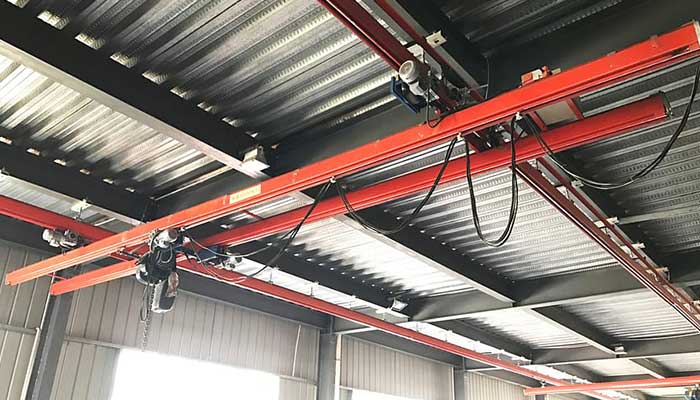 double girder overhead crane for sale
double girder overhead crane for sale 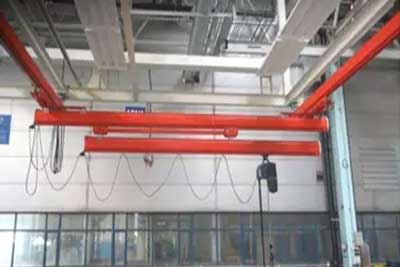 Telescoping ceiling mouned kbk crane for sale
Telescoping ceiling mouned kbk crane for sale 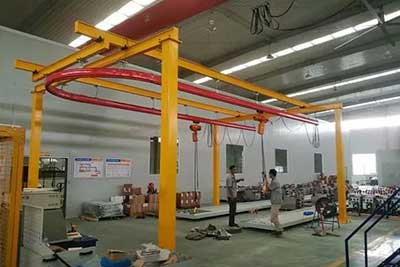 free standing monorail kbk crane for sale
free standing monorail kbk crane for sale Key Features of KBK Rail Cranes
As we explore the transformative impact of KBK Rail Cranes on heavy parts assembly in the automotive industry, it's essential to delve into the key features that make these cranes stand out. From impressive lifting capabilities to precision controls and adaptability, the KBK Rail Crane is a technological marvel designed to meet the complex demands of modern manufacturing.
Capacity and Strength
Overview of the Crane's Lifting Capabilities
The KBK Rail Crane distinguishes itself through its robust lifting capabilities, making it a formidable force in heavy parts assembly. With a lifting capacity ranging from 2 tons to 5 tons, this crane system is tailor-made to handle a diverse array of heavy automotive components. Whether it's lifting engine blocks, chassis elements, or intricate machinery, the crane's strength is a cornerstone of its effectiveness.
Key Aspects:
- Versatility:The crane's capacity to handle weights from 2 tons to 5 tons ensures versatility in handling various components of differing sizes and masses.
- Reliability:Robust construction and engineering ensure the crane's reliability in heavy parts assembly, contributing to seamless production processes.
Precision Controls
How Precise Controls Contribute to Effective Handling
Precision is paramount in heavy parts assembly, and the KBK Rail Crane excels in this regard with its advanced control systems. These precise controls offer a myriad of benefits that contribute to effective handling and positioning of heavy automotive components.
Advantages:
- Accurate Positioning:The crane's precise controls enable operators to position heavy components with unparalleled accuracy, ensuring they fit seamlessly into the assembly process.
- Reduced Error Margin:The integration of precise controls minimizes the margin for error, leading to a higher degree of consistency and quality in assembly.
Adaptability
The Crane's Ability to Adapt to Different Assembly Line Setups
The KBK Rail Crane's adaptability is a defining feature that sets it apart in the realm of heavy parts assembly. Its design allows for seamless integration into various assembly line setups, providing automotive manufacturers with a versatile and flexible lifting solution.
Key Aspects:
- Flexibility:The crane's adaptability ensures it can navigate through different stages of assembly, accommodating changes in workflow and production requirements.
- Integration:Whether it's a traditional assembly line or a more modern and automated setup, the KBK Rail Crane integrates effortlessly, contributing to the overall efficiency of heavy parts handling.
As we transition to exploring real-world projects where KBK Rail Cranes have made a substantial impact, the combination of these key features becomes increasingly apparent. Join us in the next section as we delve into specific projects in Germany, the United States, and China, where the KBK Rail Crane has proven its mettle in heavy automotive parts assembly.
Projects for Your Reference
Project in Germany
In a leading automotive manufacturing facility in Germany, the challenge was to optimize heavy parts assembly for increased efficiency and precision. The specific project aimed to enhance the production line for a new line of luxury vehicles.
KBK Rail Cranes were strategically integrated into key stages of the assembly process. Their lifting capabilities and precise controls were utilized to handle and position heavy components such as engine blocks and chassis elements.
The implementation of KBK Rail Cranes resulted in a notable improvement in assembly processes. The lifting capacity and adaptability of the cranes allowed for swift and accurate positioning of heavy parts, reducing manual handling time and minimizing the risk of errors. This led to a streamlined workflow, increased production efficiency, and ultimately, a higher quality of finished vehicles.
Project in the United States
In a cutting-edge automotive manufacturing plant in the United States, the goal was to revolutionize heavy parts assembly for electric vehicles. The project focused on optimizing the assembly line to meet the growing demand for eco-friendly vehicles.
KBK Rail Cranes were deployed to handle the unique components associated with electric vehicles, including large battery modules and specialized drivetrain elements. The cranes' precision controls were instrumental in ensuring the careful placement of these critical components.
The outcomes of incorporating KBK Rail Cranes were transformative. The cranes' adaptability to the specific requirements of electric vehicle assembly contributed to enhanced efficiency. Reduced handling time, coupled with precise positioning, led to a significant reduction in production costs and an increase in overall assembly line throughput.
The integration of KBK Rail Cranes in the Chinese automotive facility resulted in a notable increase in assembly efficiency. The cranes' ability to adapt to changing production requirements and handle a variety of heavy parts contributed to a seamless expansion process. The facility experienced reduced lead times, increased production capacity, and a positive impact on the overall efficiency of heavy parts assembly.
These case studies highlight the real-world impact of KBK Rail Cranes in diverse automotive manufacturing settings. As we move forward, we'll delve into the technological features of these cranes that contribute to their success in heavy parts assembly. Join us in the next section as we explore the precision controls, adaptability, and strength that make KBK Rail Cranes indispensable in the automotive industry.
KBK Rail Cranes, with their robust lifting capabilities, precise controls, and adaptability, have etched themselves into the very fabric of heavy parts assembly. Across diverse projects in Germany, the United States, and China, these cranes have proven indispensable in handling the intricate components that form the heart of modern vehicles.


